Paschke Online
Designs Ink Publishing Article Archive and Reference Library
Articles by Chris A. Paschke, CPF GCF
"Frameless Framing"
October 2009
Use of acrylic sheeting in mounting and framing is not new. Acrylic sheeting and face mounting has been used for the display of Cibachromes and Duratrans in advertising, backlit display and lightboxes has in Europe for over 30 years. In high school I used inexpensive acrylic boxes with cardboard inserts to hold my artwork in place—either with an air space or pressed directly against the back of the acrylic—in an attempt to make the frame disappear. Companies such as Imagery and Acrylisize, both from UK, have capitalized on current design trends by creating modern acrylic boxes and display frames to fit today's market.
Design Trends
The youth of Generation X—born roughly between 1965 to 1980—seem to prefer more simple styling, minimalism, clean lines, and more individualized looks rather than the traditional mats and frames of their parents. They shop from home, surf the web, save the earth, and expect their investments to last. This is our current group of art buyers, decorators, and consumers who are looking for something unique and designed for them—enter acrylics. The contemporary acrylic box is may have elements of high gloss or matte finish, may be frosted or opaque, used as a substrate or the entire frame presentation.
Photo 1 shows the detail of original fine art on metal displayed in a high end gallery. The art has been mounted as a suspended sheet between two sheets of acrylic glazing. These are held in place by 2" long copper screws fed through holes in each of the ¼" acrylic sheets—and the art—and spaced apart with copper sleeves, then capped with matching nuts. The art was recessed 2" inside the outer edges of the acrylic to protect its edges but it remains open air.
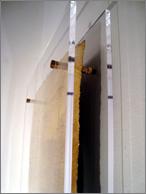 Photo 1: Acrylic Sandwich
Photo 1: Acrylic Sandwich
This original fine art on metal was on display in a high end gallery. It shows a sandwich of ¼" acrylic sheets spaced apart with 2" copper bolts and matching nuts. The bolts pass through all layers—including the art—and space the art away from the wall.
In October 2008 I discussed the permanency of face mounting a photo to the back of a sheet of acrylic. This method differs in that the art is not attached to the acrylic, but suspended between two sheets (diagram 1). This type of mounting allows constant exposure to dirt, pollution, humidity, ozone, and other deteriorating factors. Also placing holes in the art is something that can only be done by the artist or as a collaborative effort with the artist. It was a dramatically effective presentation, but not very preservation.
Frameless Framing
Frameless mounting designs have captured the attention of consumers and corporate buyers with acrylic wall décor becoming very popular for the hospitality and display industries as well as home décor. With today's capability of printing directly onto alternative substrates such as aluminum and acrylic sheeting the need for contemporary mounting hardware and display methods has launched new products and framing has really taken a turn.
As digital printing has developed so has the ability to print quality images directly onto the acrylic without the need for any paper substrate. This was never more evident than at last year's West Coast Art and Frame show in Las Vegas. Strolling through the publisher aisles there were numerous open edition print companies displaying wall art on acrylic and aluminum composite. Many open edition publishing companies have also established new wall décor divisions offering prints onto alternative substrates, as with Wild Apple Graphics new division Wild Apple Open Studio.
Commercial StandOffs
Standoffs are the name for the small diameter posts used to assemble and/or suspend acrylic panels away from the wall. They also serve as spacers between surface glazing and backing panels. Standoffs are available in bulk from fastener distribution sources online, but more decorative varieties are available from familiar framing supply distributors. Frameware Inc. offers assorted diameters from ½" to 1¼" with shaft lengths ½" to 4" in matte chrome, polished chrome, and satin stainless. LION Picture Frame Supplies Ltd, UK has developed a line of Acrylic Panel Frames to simulate the look of face mounting—they called back mounting in UK—using standoffs. LION's Acrylic Panels are from cast acrylic with polished edges and pre-drilled holes, but the posts are also sold separately. There are two basic mounting styles: the sandwich mount, using two sheets that pin the unmounted image between; and the face mount (photo 2). The face mounted print is applied to a 10mm thick clear sheet for added depth and visual effect. The problem with this mounting is the same as with any face mount, the back remains unprotected and is therefore subject to gouging damage from the rear during handling or shipping.
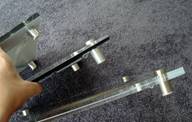 Photo 2: LION's Acrylic Frames
Photo 2: LION's Acrylic Frames
(top left to bottom right) Block mounted print to back of a thick 10mm clear acrylic sheet; photo sandwiched between 5mm clear and opaque black sheets; and sandwiched 5mm clear sheets.
Sandwiched images may be pressure mounted, flat mounted, or flush mounted. Pressure mounted sandwich panels use no adhesive, making the image safe from P-S adhesive crawl, spray adhesive bubbling, or heat damage to thermal inkjet—but the direct contact to the image may result in the surface sticking to the acrylic. Even though it is not permanently mounted, it is not a preservation method, while spacers would allow for air circulation.
Flat mounting is the centering of an image onto a decorative backing—in this case between oversized clear and opaque white, black, or frosted sheet—to create a contrasting field, much like a mat (photo 3). Posts are passed through both sheets and protrude out the back to act as both mounting screws and spacer from the wall. Another option is flush mounting the sandwich to the edges of the acrylic (photo 4). Though giving a dramatic look to the photo it does require a hole to be made in the art image to feed the posts through.
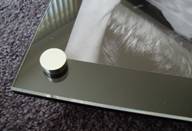 Photo 3: Opaque Border
Photo 3: Opaque Border
The photo is centered on the black opaque sheet which then acts as a contrasting mat trim. The posts go through both sheets and protrude out the back to act as both mounting screws and spacer from the wall.
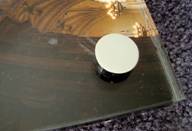 Photo 4: Flush Mount and Pressure Point
Photo 4: Flush Mount and Pressure Point
This photo is sandwiched edge to edge with a hold through the image for the standoffs. The arrow shows pressure point damage resulting from the back corner hooks pressing against the face mounted image.
Hanging or Mounting
Once the panels are assembled there are two options for hanging. One uses the posts as four corner screws that mount directly into the wall. The other is to select a more conventional hook, spring and cord system to allow for hanging to wall hooks. Swiss Clips, Gallery Clips and the UniFrame use the same type of basic cord or and spring/cord system. LION's system is called the Spring Thingyhanging system. This hardware features corner hooks that fit under the base of the standoffs against the acrylic panel and springs for tension to pull the frame flat to the wall (photo 5). LION's standoffs are available separately in brass, satin or polished chrome, and aluminum with polished silver or black anodized finishes in assorted sizes.
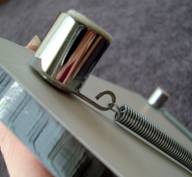 Photo 5: Corner Hooks and Spring
Photo 5: Corner Hooks and Spring
The hooks fit between the panel and the post with the spring attached for tension. A cord loops the four corners together like a Uni Frame.
One possible problem with a face mounted image is pressure point damage resulting from contact of the corner hooks against the back of the unprotected photo. Use of a small spacer preventing the corner hook from touching the photo back could eliminate this (photo 4 again).
Recto Verso Preservation
Another variation on the acrylic panel lightbox theme is a sandwich designed by artist Paula Roland, Santa Fe, NM. Paula creates sheer encaustic monoprints that require light to penetrate through them from the back, so a recto-verso mat design is the perfect solution (photo 6). The framed art is displayed as a free hanging panel suspended from the ceiling in the middle of the gallery. It is housed between back to back bevel cut mats with a sheet of ¼" frosted acrylic on the back and ¼" clear acrylic on the front (diagram 2). This allows the gallery light to penetrate through the translucent paper without actually displaying the wrong side of the art.
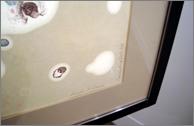 Photo 6: Free Hanging Panel
Photo 6: Free Hanging Panel
This encaustic monoprint is housed in a translucent acrylic frame unit hung suspended by cables in the center of the gallery to allow light to penetrate through. Art and frame photo courtesy of Paula Roland, Santa Fe, NM.
This preservation presentation is held together with strips of black metal surrounding perimeter of the face of the art using short crew bolts to hold it tightly together (photo 7). The detail of the screws at the back corner of the frame show the screws are perfectly sized to fit the thickness of the package. All screws and metal trim on the front were painted black (photo 8). By using double mats, air is allowed to circulate between the acrylic and the art preventing sticking or condensation. Also the cotton mats help protect seal the enclosure to better protect the art from pollution and ozone damage.
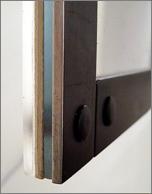 Photo 7: Corner Detail
Photo 7: Corner Detail
The art is housed between recto-verso mats backed with frosted white acrylic, topped with clear acrylic and held together by metal strips bolted at the corners. Totally preservation.
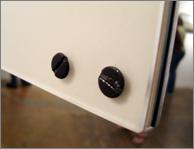 Photo 8: Back Screws
Photo 8: Back Screws
Detail of the screws at the back corner of the frame.
Final Words
Though framing has been the term used for centuries to house artwork for display, today's 21st century options have been expanded to include printing directly onto acrylic or metal while embracing acrylic as both glazing and a frame. Acrylic glazing has many faces, and so does acrylic framing. Whether inexpensive open edition reproduction or original monoprint, there may very well be an acrylic mounting application that fits the requirements. Contemporary face mounting, spaced acrylic panels, acrylic boxes, lightboxes, and digital acrylic art are all the rage. So in order to compete in today's market even the traditional framer better be able to speak "acrylic", it's more than just a glass alternative.
END
Copyright © 2009 Chris A Paschke
Note: a special thank you to LION Picture Frame Supplies, Encaustic artist Paula Roland, and Wild Apple Graphics for permission to use photos and product information in this article.
For more articles on mounting basics look under the mounting section in Articles by Subject.
Additional information on all types of mounting is found in:
The Mounting and Laminating Handbook, Second Edition, 2002,
The Mounting And Laminating Handbook, Third Edition, 2008 and
Creative Mounting, Wrapping, And Laminating, 2000 will teach you everything you need to know about getting the most from your dry mount equipment and materials as an innovative frame designer.
All books are available from Designs Ink Publishing through this website.
Chris A Paschke, CPF GCF
Designs Ink
Designs Ink Publishing
785 Tucker Road, Suite G-183
Tehachapi, CA 93561
P 661-821-2188
chris@designsinkart.com
 Photo 1: Acrylic Sandwich
Photo 1: Acrylic Sandwich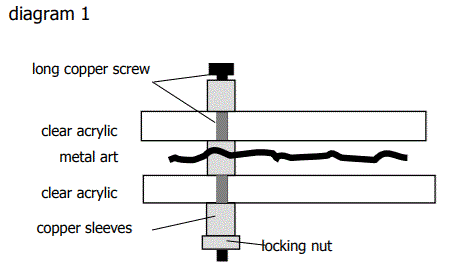
 Photo 2: LION's Acrylic Frames
Photo 2: LION's Acrylic Frames Photo 3: Opaque Border
Photo 3: Opaque Border Photo 4: Flush Mount and Pressure Point
Photo 4: Flush Mount and Pressure Point Photo 5: Corner Hooks and Spring
Photo 5: Corner Hooks and Spring Photo 6: Free Hanging Panel
Photo 6: Free Hanging Panel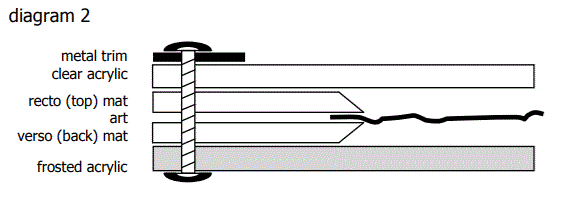
 Photo 7: Corner Detail
Photo 7: Corner Detail Photo 8: Back Screws
Photo 8: Back Screws